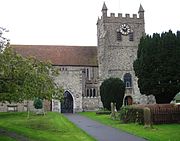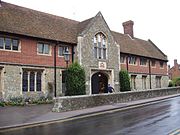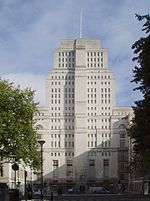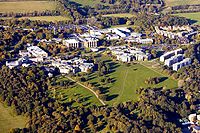- Wye College
-
The College of St. Gregory and St. Martin at Wye, more commonly known as Wye College, was an educational institution in Kent, United Kingdom. It was founded in 1447 by John Kempe, the Archbishop of York, as a college for the training of priests. It is located in the small village of Wye, Kent, 60 miles (100 km) east of London in the North Downs area. In 1894, the school moved to new premises, and the South Eastern Agricultural College was established in the buildings with Alfred Daniel Hall as principal. In 1898 Wye became a School of Agriculture within the University of London. Wye College was until 2005 a well-known study and research centre in the fields of Rural business and management, biological sciences, the environment and agriculture. One of its alumni was the gardener Christopher Lloyd. Another was John Seymour the widely published exponent of self sufficiency and small scale farming. The College was officially closed by its present owner, Imperial College, London, in September 2009.
Contents
Historical interest
On the Downs east of the village is a crown (hill figure) carved in the chalk by students in 1902 to commemorate the coronation of Edward VII. Several of the older College buildings, such as the Latin School or the Parlour, date from the fifteenth century and the main college buildings are set amidst cloistered quadrangles and gardens. They are protected by a Grade 1 listing.
Academic and learning centre
The Wye campus developed from 1894 until 2000. It occupies a 3 km² estate, which includes a farm, managed woodland and ancient grassland that provide outstanding research resources for agroecological research. These resources were augmented by extensive glasshouses, climate-controlled growth rooms for plants and insects, and a containment facility for transgenic plants that supported laboratory-based research. There were dedicated laboratories for plant molecular biology, genomics and gene sequencing, electron microscopy, use of radiochemicals, microbiology, soil analysis, and plant/animal cell culture. Some of these lab facilities have now been removed by Imperial College. There are student halls and other buildings dotted around the village.
Students from all over the world followed undergraduates or postgraduates courses in fields related to agriculture, biology and food marketing. Distance-learning was also headquartered on campus. Numerous conferences and seminars were also run for professionals, and short-term students. Some of the better know academics teaching on campus included Prof. Michael Redclift (Emeritus, King's College London); Prof Ken Giller (Wageningen University), and Nick Russell, formerly Bridge Wardens' Professor of microbiology,
In 2000 Wye College lost its status as a College within the federal University of London and merged with Imperial College London, renamed as Imperial College at Wye. While there was some opposition, the reasons cited were financial and pragmatic, and Imperial agreed to keep agricultural teaching and research on the campus. It did wish to move the social scientists and economists to London, and this forced several staff departures.
The first Provost of Imperial College at Wye was Professor Tim Clark. Commenting on his new appointment, Professor Clark said: "Wye College has a well-deserved reputation for excellence in teaching and research. I am looking forward to acting as Wye's champion and helping to preserve and build on all that is so special here."[1]
These and other promises made by Imperial turned out to be unreliable. In 2004, with a new Imperial Rector (Richard Sykes) they announced that the Department of Agricultural Sciences was closing, and that most teaching and research at Wye would end.[2] In 2005 it was announced that Wye College would be converted into a research centre for non-food crops and biomass fuels, with the support (a 'concordat') between Kent County Council and Ashford Borough Council.[3] Some 12,500 jobs were promised, but funding for the project remained uncertain, and villagers were kept in the dark about the scale of the proposals until a public meeting organised by Imperial.[4] Opposition quickly began, and leaks of official documents (some of them held at a concealed website to avoid Freedom of Information requests) to a local campaigning website,[5] have shown that the principal aim of the plan, particularly once an industry partner fell through, soon became to raise £100 million for Imperial projects in London by building thousands of houses and commercial developments on protected countryside around Wye that has Area of Outstanding Natural Beauty status. A new motorway link was also proposed. The plan provoked bitter opposition both locally and nationally and was seen as a test case for other attempts to build on AONB land.
On September 15, 2006, Imperial announced it was abandoning the plan altogether after support was withdrawn by Ashford Borough Council following widespread complaints from the public, and the publication by save-wye of a hitherto secret map showing the vast extent of the draft development proposal. The Imperial masterplan was in fact for four thousand homes on the green AONB land.[6][7]
This decision was hailed by environmentalists as a key victory to preserve the status of Area of Outstanding Natural Beauty, and for local campaigners it stopped Wye becoming a much larger town. The failed project cost Imperial at least £1 million in professional fees, prompted resignations, and may be the subject of an independent legal inquiry into the actions of the local authorities involved.[8] One legal issue was that all three parties colluded to keep the scale of their draft proposals out of the public eye. There was a project website held by management consultants from where the 'map' of the proposal was eventually leaked.[9]
After this debacle, the University of Kent agreed to run some undergraduate business management courses from the College buildings in 2007, but this proved short-lived, and Kent's School of Economics and Kent Business School now operates from its main Canterbury site.
The College today
 The Wye College campus was closed in September 2009 and Imperial College are now seeking to develop the estate or to find suitable tenants for it.[10] Most of the College farmland is currently leased to an ex-Wye College student, Mr. Atwood, until 2019. Most of the buildings are still for rent - an effort by Imperial to sell off Withersdane Hall was halted with Council intervention.[11] A proposal to restore the agricultural College, with accreditation from the University of Buckingham, was advanced in 2010, but would rely on Imperial releasing freehold buildings that it may still be trying to develop.[12] The loss of Wye College is lamented by many.
The Wye College campus was closed in September 2009 and Imperial College are now seeking to develop the estate or to find suitable tenants for it.[10] Most of the College farmland is currently leased to an ex-Wye College student, Mr. Atwood, until 2019. Most of the buildings are still for rent - an effort by Imperial to sell off Withersdane Hall was halted with Council intervention.[11] A proposal to restore the agricultural College, with accreditation from the University of Buckingham, was advanced in 2010, but would rely on Imperial releasing freehold buildings that it may still be trying to develop.[12] The loss of Wye College is lamented by many.Hops
One of Wye College's major contributions was the development of a number of new strains of hops used in the brewing of beer. These new varieties include Challenger, Northdown, Target and Yeoman.[13] This research has now been relocated to nearby Harbledown and operates as Wye Hops Ltd.
See also
References
- ^ http://www.imperial.ac.uk/college.asp?P=1360
- ^ http://www.hese.ac.uk/hese/news/downloads/ic_london_statement_wye.pdf
- ^ http://www.imperial.ac.uk/college.asp?P=7130
- ^ David Hewson. 2007. Saved; How an English village fought for its survival and won. Leicester: Troubador Publishing
- ^ http://www.save-wye.org
- ^ Wye Community Land Trust: An organisation set up to bid for the tenancy of the Wye College farm, and run it on behalf of the community.
- ^ David Hewson. 2007. Saved; How an English village fought for its survival and won. Leicester: Troubador Publishing
- ^ http://www.felixonline.co.uk/v2/article.php?id=2741
- ^ David Hewson. 2007. Saved; How an English village fought for its survival and won. Leicester: Troubador Publishing
- ^ http://www3.imperial.ac.uk/wyecampus/
- ^ see wsvi "dot" wordpress.com/
- ^ http://phoenixwyecollege.co.uk
- ^ Wheeler, G, "Home Brewing", CAMRA, 1993
External links
- Imperial at Wye
- A. D. (Sir Alfred) Daniel Hall *FRS
- http://www.kent.ac.uk/kbs/school-information/news.html#imperial
- save-wye.org
- [1]
University of Kent University People · Students' Union · Academic dress · T24 Drama Society · British Cartoon Archive · University of Kent Rowing Club · UKC RadioColleges Departments Campuses Miscellaneous Categories Categories:- 1447 establishments in England
- Ashford, Kent
- Education in Kent
- Imperial College London
- University of Kent
- Former colleges of the University of London
- Christianity in Kent
- Grade I listed buildings in Kent
- Educational institutions established in the 15th century
Wikimedia Foundation. 2010.



